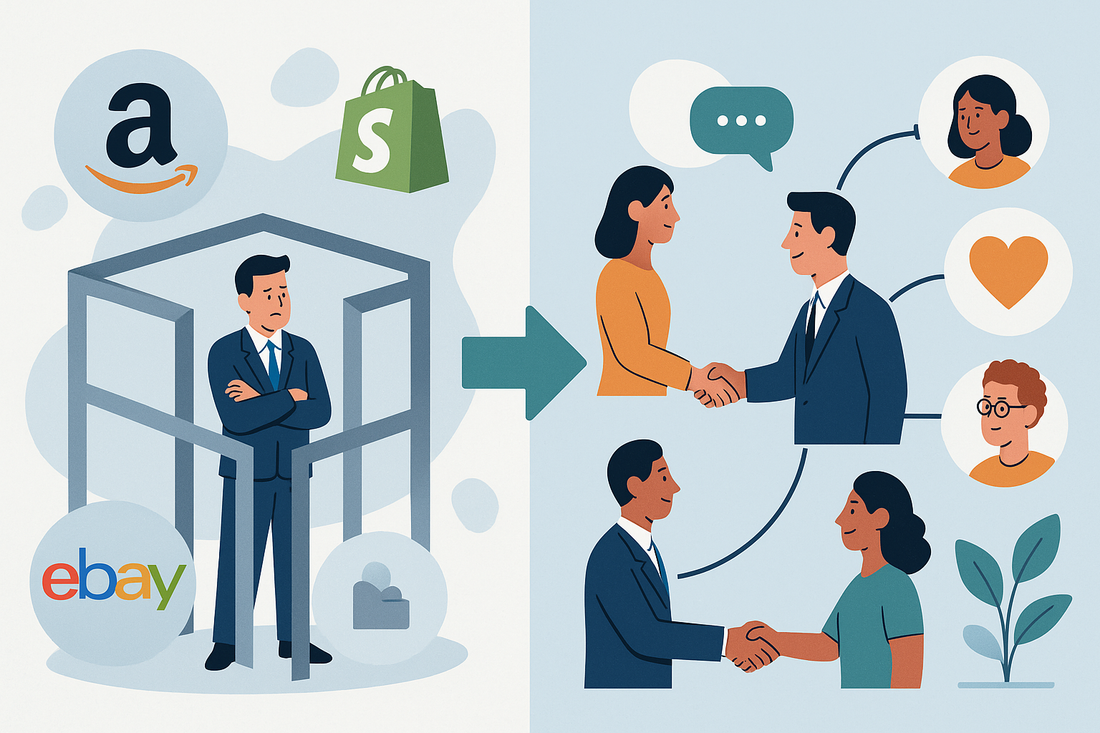
The Mindset Shift Every Seller Needs to Thrive Off-Marketplace
Share
Introduction
For many marketplace sellers, success feels like it’s tied to one thing: the algorithm. Whether it’s eBay, Amazon, or TikTok Shop, the fear of slipping in search rankings or getting caught in a policy change can keep you up at night. But here’s the thing: building a business on rented land means the rules can change at any time. What if the rules worked in your favour, not against you?
That’s where the mindset shift from platform-dependent to customer-centric comes in. It’s not about abandoning marketplaces altogether—it’s about making sure they’re just one piece of your growth strategy, not the whole game.
Why Platform Dependency is Risky
Marketplaces are incredible for reach, but they also control:
- Your visibility – one tweak in the search algorithm and sales can vanish overnight.
- Your fees – a small increase here, a new charge there, and your margins shrink.
- Your customer relationships – most platforms keep buyer data locked away.
When you rely 100% on marketplaces, you’re betting your future on decisions you can’t influence.
Shifting to a Customer-First Mindset
A customer-first business is one where the relationship is with you, not the platform. This means your customers know your brand, remember your service, and—most importantly—come back to you directly.
Here are practical steps to start that shift:
- Build your brand presence – even while selling on marketplaces, add touches that reflect your brand, like custom packaging or branded inserts. Consider a branded store via Shopify or Wix.
- Capture customer data ethically – use opt-in offers such as discounts or exclusive previews to get email signups.
- Offer memorable post-purchase experiences – follow up with care tips, thank-you notes, or personalised offers.
- Diversify your channels – don’t just sell where the buyers are, also market where your audience hangs out. That could mean Instagram, Facebook, or niche communities.
Resilience in a Customer-Centric Model
When you focus on customer loyalty over platform loyalty, your business becomes more resilient. If one channel slows down, you still have email subscribers, social followers, and a direct store to keep revenue flowing.
Think about it like this: marketplaces are the highway—fast and full of opportunity—but you also need your own side roads where the traffic is yours alone.
Turning Mindset into Measurable Results
Shifting your approach isn’t just feel-good strategy—it’s measurable. Sellers who invest in customer-first systems often see:
- Higher repeat purchase rates
- Lower acquisition costs over time
- More freedom in pricing and promotions
Tools like MailerLite for email marketing, Gorgias for customer service, and Databox for performance tracking can help you get there faster.
FAQs
Do I have to stop selling on marketplaces to be customer-first? Not at all. The goal is balance—using marketplaces for reach while building direct relationships elsewhere.
What if I don’t have time to build a separate brand? Start small. Even consistent branding and post-sale communication can shift perception over time.
How long does it take to see results? Typically, sellers see stronger retention within 3–6 months of consistent customer-first practices.
Conclusion
Making the shift from platform-dependent to customer-centric isn’t an overnight change—it’s a long game. But it’s the game that puts you in control. You’ll keep the reach of marketplaces while gaining the stability of a loyal customer base. That’s the kind of business that grows steadily, survives industry shifts, and isn’t at the mercy of a single algorithm.
Want to start making the shift today? Sign up for the 30 Day Newsletter and get practical tips to help you build a customer-first business one step at a time.
